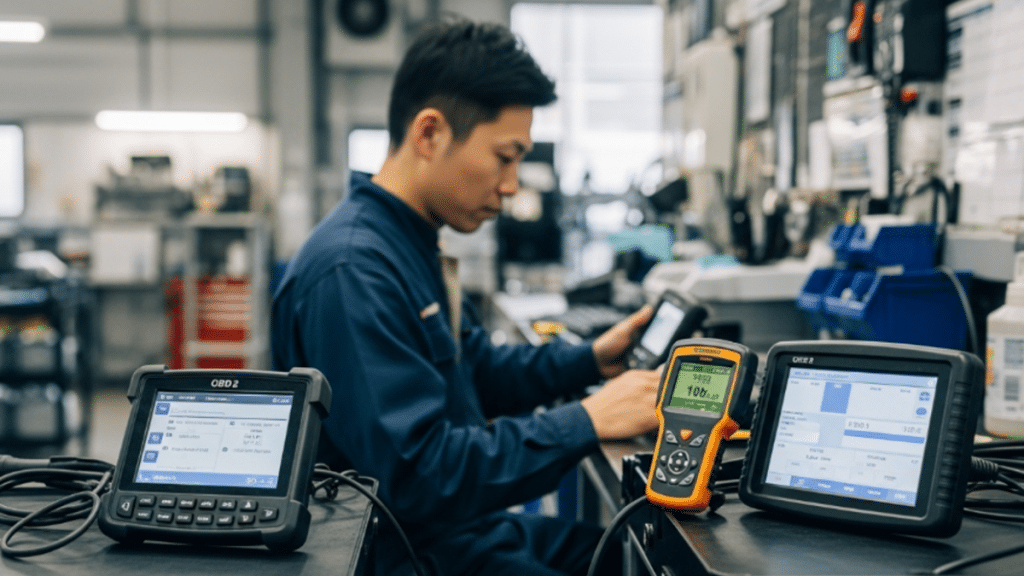1. Introduction: Why Two Tools for One Car?
When it comes to car maintenance, many drivers and even some technicians assume that a single OBD2 scanner can handle all vehicle diagnostics—including tire pressure issues. But that’s not quite accurate.
Modern vehicles are complex machines with systems that often require specialized tools. Tire Pressure Monitoring Systems (TPMS) are one such case. While an OBD2 scanner can read and clear engine-related trouble codes, it may fall short when it comes to resetting or reprogramming TPMS sensors.
Want to skip ahead and see compatible tools? Check out our full selection of TPMS scanners.
2. What OBD2 Scanners Can (and Can’t) Do
What they can do:
- Read and clear diagnostic trouble codes (DTCs), mostly related to the engine and emission system.
- Offer real-time data like fuel trims, oxygen sensor readings, and RPM.
- Provide insight into performance and fuel efficiency issues.
What they can’t do (in most cases):
- Access TPMS modules directly.
- Reset TPMS sensors or perform relearn procedures.
- Reprogram or activate TPMS sensors after tire replacement.
In short, OBD2 scanners are great for engine diagnostics, but not enough for managing TPMS-related tasks.
3. What Makes a TPMS Scanner Different?
TPMS scanners are designed specifically to interface with your vehicle’s tire pressure monitoring system. Unlike basic OBD2 tools, they:
- Communicate directly with TPMS modules.
- Read and clear TPMS-specific trouble codes.
- Trigger, program, and relearn TPMS sensors.
- Display live data including pressure, temperature, and battery levels of each sensor.
These capabilities are essential when rotating tires, replacing sensors, or dealing with TPMS warning lights.
4. When Do You Actually Need a TPMS Scanner?
You likely need a dedicated TPMS scanner if:
- You’ve just changed your tires or TPMS sensors.
- Your dashboard shows the TPMS warning light.
- You’re a technician or DIYer aiming for full diagnostic capability.
Trying to reset TPMS using a standard OBD2 scanner may not only fail—it could also lead to misdiagnosis or persistent warning lights.
5. Recommended Tools: OBD2 or TPMS—or Both?
If you’re trying to choose between tools, consider what you’re trying to fix.
For general engine diagnostics:
Foxwell NT301 is an excellent mid-level OBD2 scanner that handles most engine and emission tasks with ease.
For tire pressure diagnostics and resets:
Foxwell NT310 is a dedicated TPMS tool with features for sensor activation, programming, and relearn.
Foxwell NT530 offers both TPMS support and full-system diagnostics, including ABS, airbag, and more. It also supports bi-directional control and OEM-level software for various car brands.
For many car owners and professionals, having both tools can offer comprehensive coverage and peace of mind.
6. Conclusion: Choose the Right Tool for Safer Driving
Understanding the difference between OBD2 and TPMS scanners can save you time, money, and frustration. If you’re dealing with a TPMS warning light or installing new sensors, a TPMS scanner isn’t just helpful—it’s essential.
For complete diagnostics, consider combining both tools. That way, whether it’s a check engine light or tire pressure alert, you’re always ready.
Ready to upgrade your toolkit? Browse our complete lineup of TPMS scanners for trusted tools that get the job done right.
[Meta description: Understand the difference between OBD2 Scanner and TPMS Scanner—and find the right tool to reset and reprogram your TPMS.]

